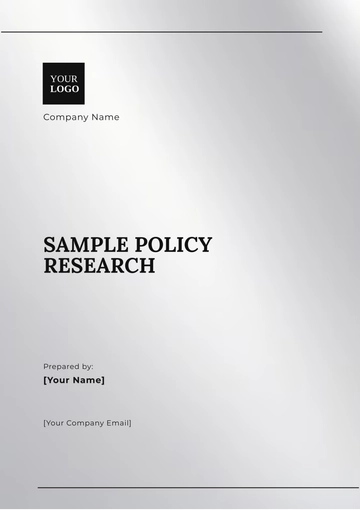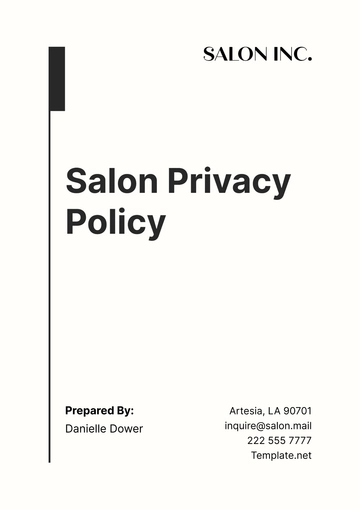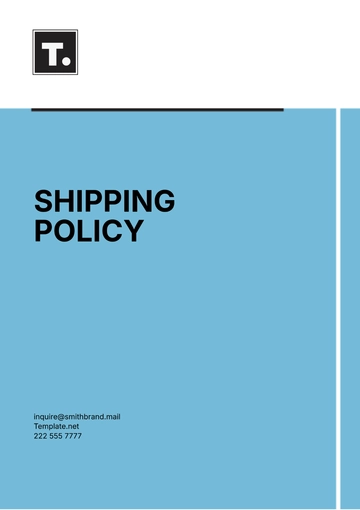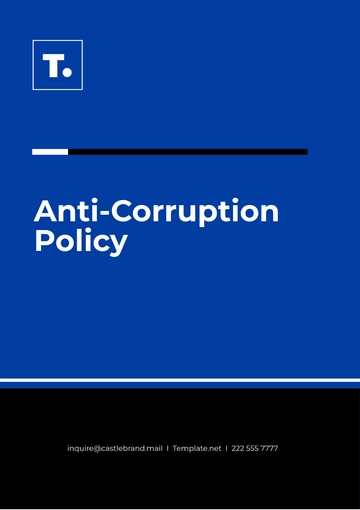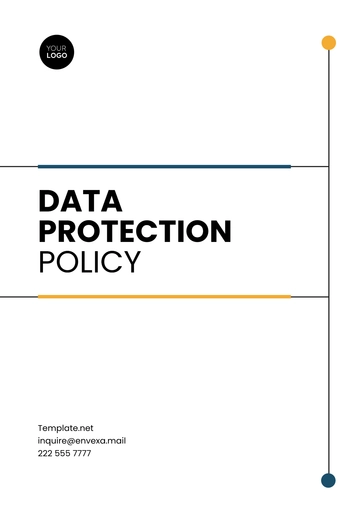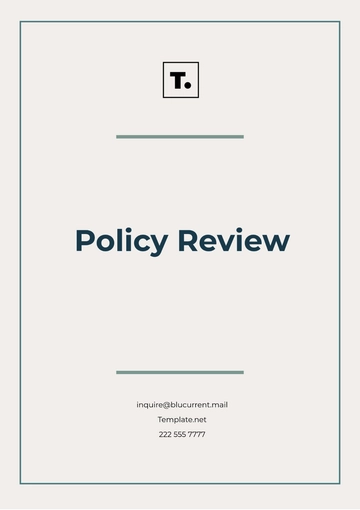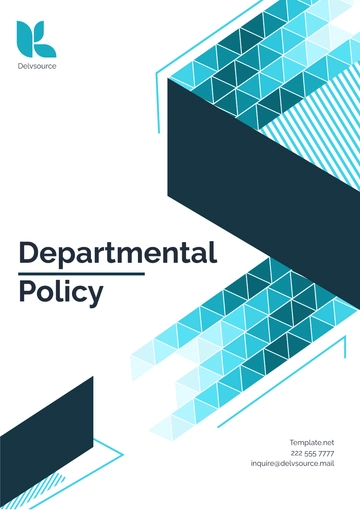Free Advertising Investment Policy & Procedure

I. Introduction
Background
In recognition of the dynamic landscape of contemporary marketing and the pivotal role advertising plays in shaping brand narratives, this section provides a nuanced exploration of the organization's advertising evolution. Tracing the trajectory from past campaigns to current market positioning, it offers insights into the transformative forces that necessitate a refined approach to advertising investment.
Purpose
Elevating clarity and purpose, this segment succinctly defines the raison d'être of the Advertising Investment Policy & Procedure. It serves as a strategic compass, aligning the organization's advertising endeavors with overarching business objectives, fostering consistency, and fortifying a robust foundation for future campaigns.
Scope
Delving into the parameters that demarcate the policy's applicability, this subsection articulates the precise contours within which the policy operates. It delineates the realms of advertising activities, encapsulating the diverse channels, platforms, and contexts that fall under its purview. This clarity ensures a focused and comprehensive approach to the development and implementation of the policy.
II. Objective Definition
Overall Advertising Objectives
In this section, we meticulously outline the overarching objectives that underpin our advertising endeavors. These objectives serve as the guiding principles shaping the organization's brand presence, market positioning, and overall strategic impact. The articulation of these high-level goals ensures a unified vision, aligning advertising activities with the broader mission and business strategy.
Specific Campaign Goals
Within the realm of each advertising campaign, we delve into the intricacies of specific goals and desired outcomes. By establishing granular objectives, we create a roadmap for campaign planning and execution. These specific goals provide a targeted framework, enabling the organization to measure the effectiveness of each campaign against predefined benchmarks. Through this detailed approach, we aim to optimize our advertising efforts, ensuring they are not only aligned with overarching objectives but also finely tuned to achieve measurable and impactful results.
In essence, this section serves as the foundation for our advertising strategy, seamlessly connecting the broad organizational objectives with the nuanced and campaign-specific aspirations. Through a meticulous delineation of both overall and campaign-specific objectives, we set the stage for a strategic, purpose-driven, and results-oriented approach to advertising.
III. Budget Allocation Criteria
Efficient allocation of advertising budgets is paramount to achieving optimal results. This section outlines the meticulous criteria employed in determining the financial resources earmarked for advertising endeavors.
Determining Advertising Budgets
To establish a robust foundation for budgetary decisions, a multi-faceted approach is employed. This involves:
Market Analysis: Rigorous examination of market dynamics, including trends, competitor activities, and consumer behavior, to inform budgetary considerations.
Historical Performance: Evaluation of past advertising campaigns to glean insights into successful strategies and areas for improvement.
Factors Influencing Budget Allocation
A structured set of factors guides the allocation of advertising budgets, ensuring a judicious distribution of resources. These factors include:
Campaign Objectives: Aligning budgetary allocations with the specific goals of each advertising campaign, be it brand awareness, lead generation, or other strategic outcomes.
Target Audience Reach: Considering the size and demographics of the target audience, optimizing budget allocation to maximize reach and impact.
Channel Effectiveness: Assessing the historical performance and potential impact of advertising channels to prioritize budget allocation to the most effective platforms.
Budget Approval Process
Transparency and accountability are integral to the budget approval process. This involves a well-defined series of steps:
A. Budget Proposal Submission
The advertising team submits a detailed budget proposal, including anticipated expenses, justification for allocations, and expected outcomes.
B. Stakeholder Review
Key stakeholders, including marketing, finance, and executive leadership, conduct a comprehensive review of the budget proposal.
C. Decision-Making Criteria
Decisions are based on a consensus-driven approach, considering the alignment of the proposed budget with organizational goals, market conditions, and campaign objectives.
D. Reallocation Flexibility
In recognition of the dynamic nature of advertising landscapes, a mechanism for reallocation of budgets during campaigns is established, enabling agile responses to emerging opportunities or challenges.
Table: Budget Allocation Overview
Criteria | Weightage | Justification |
Market Analysis | 30% | Informed budgetary decisions based on current market trends and competitor activities. |
Historical Performance | 25% | Utilizing insights from past campaigns to refine budget allocations for improved efficacy. |
Campaign Objectives | 20% | Aligning budget allocations with specific campaign goals to maximize impact. |
Target Audience Reach | 15% | Optimizing budget distribution to ensure maximum reach within identified target demographics. |
Channel Effectiveness | 10% | Prioritizing budget allocation to channels with proven historical performance and impact. |
This comprehensive approach to budget allocation ensures a strategic and data-driven distribution of resources, fostering impactful advertising campaigns while maintaining fiscal responsibility.
IV. Approval Processes
Stakeholder Roles And Responsibilities
Clearly delineate the roles and responsibilities of key stakeholders involved in the approval process. This section provides a detailed breakdown of the individuals or teams responsible for decision-making at various stages of advertising initiatives.
Advertising Steering Committee
Establishes a high-level committee responsible for overseeing the overall advertising strategy and approving major campaigns. Defines the roles of committee members, including the Chairperson, Marketing Director, and Finance Representative.
Campaign Approval Teams
Outlines the composition and responsibilities of teams dedicated to specific campaigns. Ensures cross-functional collaboration, with representatives from Marketing, Legal, and Finance, to evaluate and approve campaign proposals.
Decision-Making Workflow
Illustrate the sequential steps involved in the approval process, providing a visual representation of the workflow. This section elucidates the journey of an advertising initiative from conception to execution, incorporating key decision points and the necessary approvals at each stage.
Proposal Submission
Details the process of submitting advertising proposals, including the required documentation and information. Emphasizes the importance of a comprehensive proposal to facilitate informed decision-making.
Initial Review
Specifies the initial review phase, where the Advertising Steering Committee assesses the alignment of proposals with overall organizational objectives. This stage sets the foundation for subsequent detailed evaluations.
Cross-Functional Evaluation
Highlights the collaborative evaluation process involving representatives from Marketing, Legal, and Finance teams. Each team provides expert insights to ensure a well-rounded assessment of the proposal's viability and compliance.
Final Approval
Defines the conclusive step in the decision-making workflow, where the Advertising Steering Committee reviews the comprehensive evaluation and provides the final approval for the advertising initiative.
Escalation Procedures
Establishes a clear framework for escalating matters that require higher-level attention. This section outlines the protocol for addressing disputes, disagreements, or exceptional cases that warrant further consideration beyond the standard approval process.
Dispute Resolution Mechanism
Details the process for resolving disagreements within the approval teams, emphasizing open communication and collaboration to reach consensus.
Executive Escalation
Specifies the pathway for matters that cannot be resolved at lower levels, outlining the steps for escalating issues to the executive leadership for a final decision.
The Approval Processes section provides a robust framework that ensures transparency, accountability, and efficient decision-making throughout the advertising initiative lifecycle. By defining stakeholder roles, illustrating decision workflows, and establishing escalation procedures, this framework safeguards the integrity of the approval process while fostering collaboration among diverse functional teams.
V. Risk Mitigation Strategies
Risk Identification
Thoroughly identify potential risks associated with advertising investments through comprehensive market analysis, competitor monitoring, and scenario planning. Categorize risks based on their potential impact on campaign success.
Mitigation Planning
Develop detailed mitigation plans for identified risks, outlining proactive measures to minimize their impact. Ensure that mitigation strategies are tailored to the specific nature of each risk, fostering resilience against unforeseen challenges.
Contingency Measures
Establish robust contingency measures to address risks that may not be entirely mitigated. Clearly define protocols for swift and effective responses, enabling the organization to navigate uncertainties while maintaining campaign objectives.
In this section, the organization systematically identifies, plans for, and addresses potential risks associated with advertising initiatives. Through proactive risk mitigation and strategic contingency planning, the organization aims to fortify its campaigns against unforeseen challenges, fostering resilience and ensuring the continued pursuit of advertising objectives.
VI. Media Planning And Buying Guidelines
Channel And Platform Selection Criteria
This section provides a systematic approach for selecting the most effective advertising channels and platforms. It outlines criteria such as audience demographics, reach, and engagement potential, ensuring a data-driven decision-making process.
Negotiation And Purchasing Protocols
Detailing the negotiation and purchasing processes, this section establishes standardized protocols for securing optimal terms and rates with media outlets. It emphasizes strategic negotiation techniques and adherence to budgetary constraints.
Vendor Evaluation
A structured approach to evaluating advertising vendors is presented, encompassing factors like reliability, performance history, and alignment with campaign objectives. This ensures the engagement of reputable partners, fostering successful and mutually beneficial collaborations.
These Media Planning and Buying Guidelines serve as a blueprint for the meticulous selection, negotiation, and evaluation of advertising channels, enhancing the efficiency and effectiveness of the overall advertising strategy.
VII. Performance Metrics And Evaluation
Key Performance Indicators (KPIs)
Define a set of precise and measurable Key Performance Indicators (KPIs) tailored to gauge the success of advertising campaigns. These indicators should align with the overarching advertising objectives and provide actionable insights into campaign effectiveness.
Post-Campaign Evaluation
Establish a systematic post-campaign evaluation process to analyze the performance against predefined KPIs. This includes a comprehensive review of campaign reach, engagement, and conversion metrics, facilitating the identification of successful strategies and areas for improvement.
Continuous Improvement Strategies
Outline strategies for continuous improvement based on the insights gathered from post-campaign evaluations. This involves adapting future campaigns based on lessons learned, refining targeting approaches, and staying agile to evolving market trends. Foster a culture of ongoing optimization to enhance the overall effectiveness of advertising initiatives.
VIII. Compliance And Legal Considerations
Regulatory Frameworks
This section meticulously outlines the legal landscape within which advertising initiatives operate. It encapsulates an exhaustive examination of relevant local, national, and international regulations to ensure full compliance with applicable laws.
Intellectual Property And Copyright
In addressing the critical aspects of intellectual property and copyright, this subsection elucidates the measures in place to safeguard against infringement, outlining protocols for the lawful creation and dissemination of advertising content.
Advertising Standards Compliance
Detailing a commitment to upholding industry standards, this part delves into the specifics of ensuring that all advertising materials adhere to ethical norms and industry guidelines, promoting a culture of responsible and transparent advertising practices.
In sum, the Compliance and Legal Considerations section serves as a robust shield, ensuring that all advertising endeavors not only meet legal requirements but also uphold the highest standards of integrity and ethical conduct.
IX. Data Privacy And Ethics
Ethical Advertising Practices
Ensure that all advertising initiatives uphold the highest ethical standards, promoting honesty, transparency, and fair representation. This section emphasizes the importance of maintaining integrity in communication and fostering trust with the audience.
Data Collection And Usage Protocols
Establish strict protocols for the collection and utilization of consumer data, emphasizing respect for privacy rights. Clearly define the permissible methods of data collection, storage, and processing, aligning with relevant data protection regulations.
Consumer Privacy Compliance
Highlight the organization's commitment to compliance with consumer privacy laws and regulations. Specify measures to obtain explicit consent for data collection, provide opt-out options, and safeguard sensitive information, fostering a trustworthy and responsible approach to data handling.
This section underscores the organization's dedication to ethical advertising practices and responsible data management, ensuring a respectful and compliant approach to consumer privacy.
X. Reporting And Documentation
Reporting Formats And Frequency
Specify the formats for comprehensive and accessible reporting on advertising expenditures and campaign performance. Establish a clear frequency for reporting, ensuring timely updates for informed decision-making.
Documentation Standards
Define meticulous documentation standards for all aspects of advertising activities. This includes campaign plans, financial records, and approvals, fostering transparency and accountability.
Audit And Compliance Procedures
Detail the procedures for internal and external audits to validate adherence to the Advertising Investment Policy. Emphasize compliance with regulatory standards, ensuring the organization operates within legal and ethical frameworks.
This section serves as a robust framework for systematic reporting and documentation, facilitating the organization's ability to analyze and optimize advertising strategies while upholding transparency, accountability, and compliance.
- 100% Customizable, free editor
- Access 1 Million+ Templates, photo’s & graphics
- Download or share as a template
- Click and replace photos, graphics, text, backgrounds
- Resize, crop, AI write & more
- Access advanced editor
Unleash the potential of your advertising investment with Template.net's Advertising Investment Policy & Procedure Template. Easily editable in our Ai Editor Tool, it offers customizable options to suit your unique business needs. Increase efficiency while ensuring consistency and governing your advertising investment strategies better. Let this template handle the technicalities while you focus on the big decisions. Experience ease, simplicity and effectiveness like never before.
You may also like
- HR Policy
- Restaurant Policy
- Company Policy
- Accounting Policies and Procedures
- Website Policy
- Privacy Policy
- Safety Policy
- School Policy
- IT and Software Policy
- Law Firm Policy
- Construction Policy
- Interior Design Policy
- Travel Agency Policy
- Education Academic Policy
- Security Policy
- Real Estate Policy
- Expense Policy
- Software Policy
